Lumps, bumps and clumps—sounds like a medical show. What causes these in our poured paintings and how can you avoid them in the future? Most of the time they are easy to predict and avoid. Here we are going to troubleshoot the reasons and provide tips on how to avoid them in the future.
Floetrol
First culprit is Floetrol. You will need to strain the Floetrol prior to adding it to your paint. This picture demonstrates why.
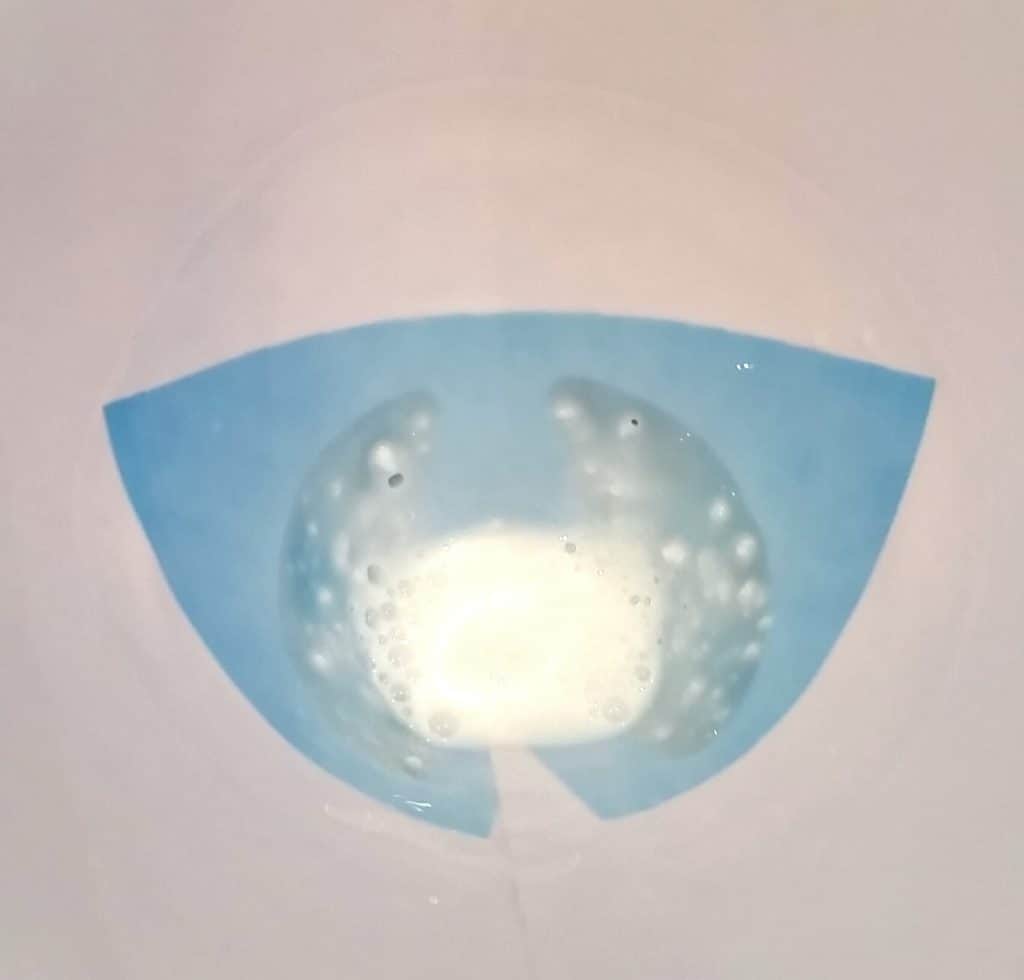
I use a disposable paint strainer every time I use Floetrol as it normally will have these lumps in it that will go directly onto your canvas if you don’t stain first. It’s easy to do and prevents the nasty surprise of lumps in an otherwise beautifully smooth surface.
Unmixed Paint
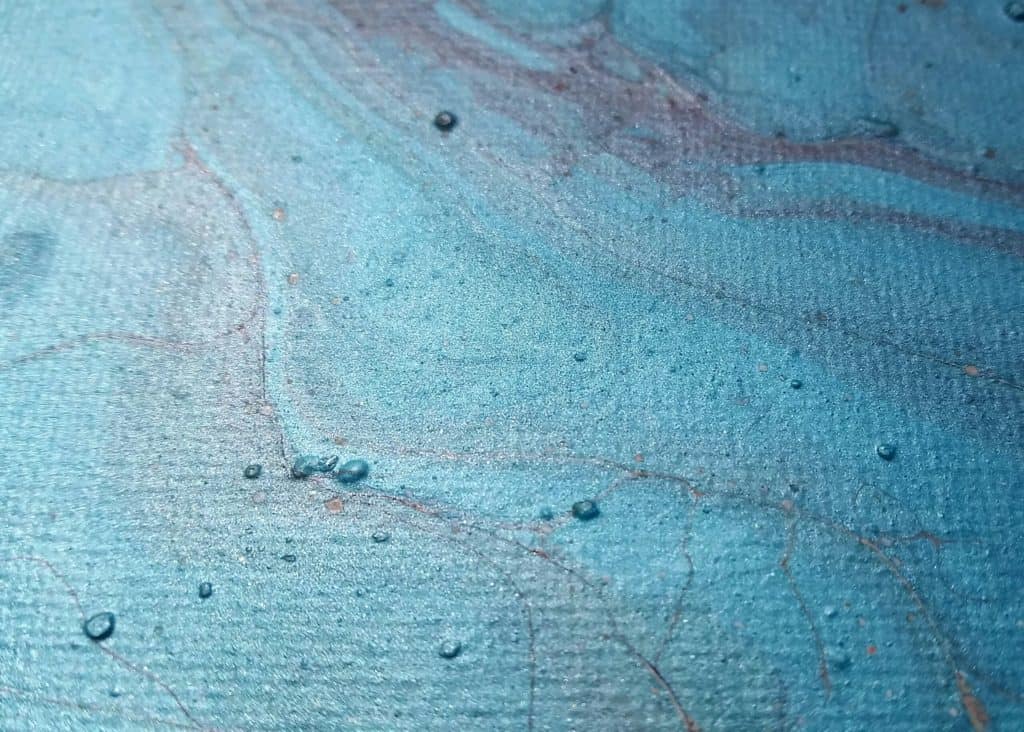
You have strained the Floetrol and you see hard lumps under the surface that don’t smooth out or pop with a torch. These are likely to be unmixed paint. Especially if you are using a thicker paint and trying to mix it in with a medium. Try this next time: pour a little medium in the cup first and then add your paint. Mix this with a stir stick by smashing it up against the sides of the cup. Once you are comfortable that all clumps are gone, continue adding medium to desired consistency.
Dust or Floaters in the Air
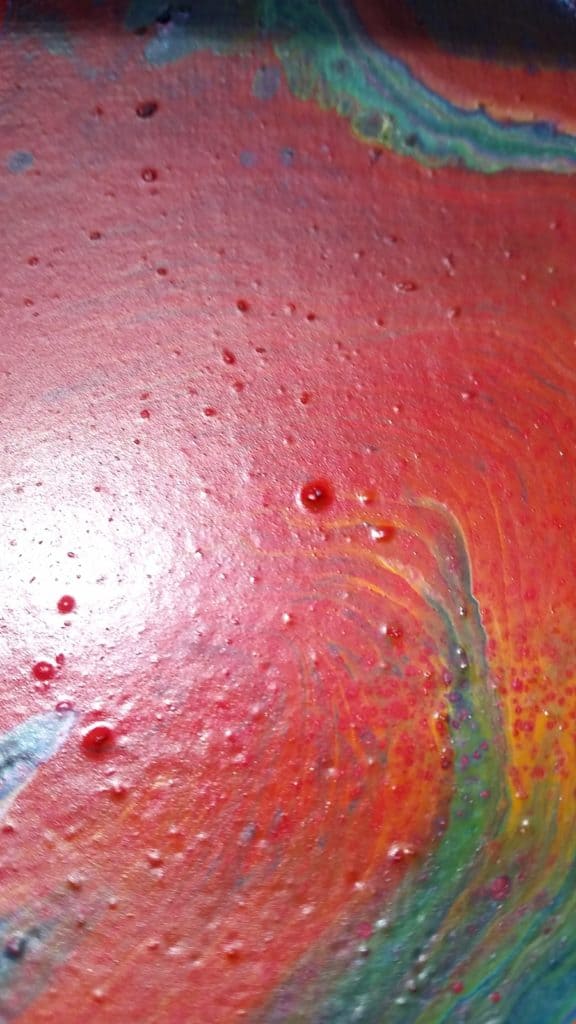
This picture shows a combination of lumps, bumps, and clumps. A sign that I was really lazy that night. I didn’t wipe off the canvas prior to painting, so who knows what pieces of dust, lint or other floaters were under there. I got the canvas out of the closet, it hadn’t been covered by anything and I’m not sure how long it had been sitting up there. So, to avoid this, be sure to wipe off your canvas with a barely damp soft cloth to remove all dust, lint, hair or anything else that might have settled on it, even if just sitting uncovered overnight. This ugly result was the accumulation of all the floater and my laziness to clean it off first. The next morning it was tossed, no way to save it.
Paint is Too Thick
Ever have a painting look great until it starts to dry then you realize there are the long waves of thickened paint or larger clumps that you can’t explain?

In this picture you can see what it might look like when dried, this was from one or more of the paints being too thick. Be sure you test the consistency of the paint prior to adding to your pour cup or pouring directly on the canvas. The paint in the cup when drizzled off the end of your stir stick should be smooth with the paint in the cup. If the paint drizzle sinks into the paint, its too thin; if it forms a mound, its too thick. Adjust your mix accordingly.
This includes your base layer. Don’t be fooled by thinking the base coat can be thicker as long as the rest of your pour is the right consistency. That’s what happened here. The white base coat was too thick and as the poured paint tried to flow over the top, it ended up pushing rather than flowing, creating the thickening globs as it dried.
Paint is Too Thin
So, you have a nice consistency on all paint except one which just might be a little thin. Can that cause problems?
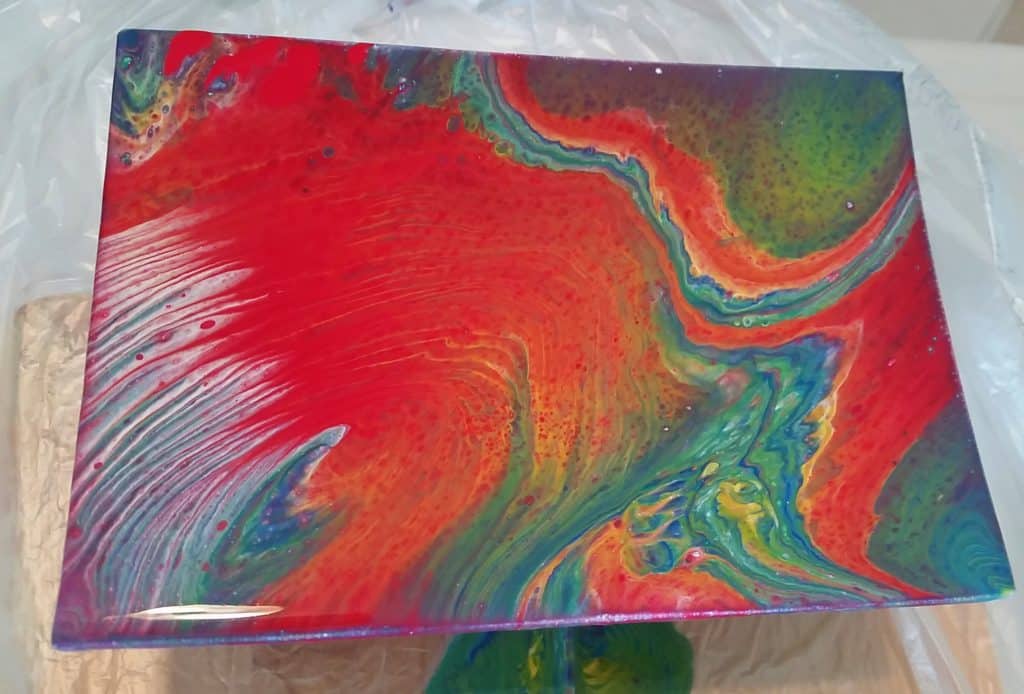
Yes of course. Here you can see the red paint was too thin and although in some areas it did fine, others like the edge it almost disappeared under the white and the same with the yellow in the middle. The spots shown, and not covering over a base layer are telltale signs of paint that is too thin.
Refer to consistency in paragraph above related to how to mix the correct paint consistency.
Silicone/Cells
You added silicone but the cells are so tiny it doesn’t look right or it’s just not what you wanted or expected. Why?
![]()
Silicone is a great additive to use to create cells, but it too must be handled with care. Here you can see tiny cells that just look like messy soap bubbles. This was the result of mixing too much. If you use a thin silicone like treadmill oil, you should only stir the silicone/paint mix three to four times, otherwise you will break down the silicone causing these tiny results. If you use coconut oil, you can stir six to eight times as it is a thicker silicone and will not break down as easily.
Colors are Muted or Muddied When Dried
You have carefully chosen your colors for your pour, and everything goes great—until it dried. Then you notice it is blah, the colors don’t pop and the contrast that was there in the wet pour has totally faded. Why?
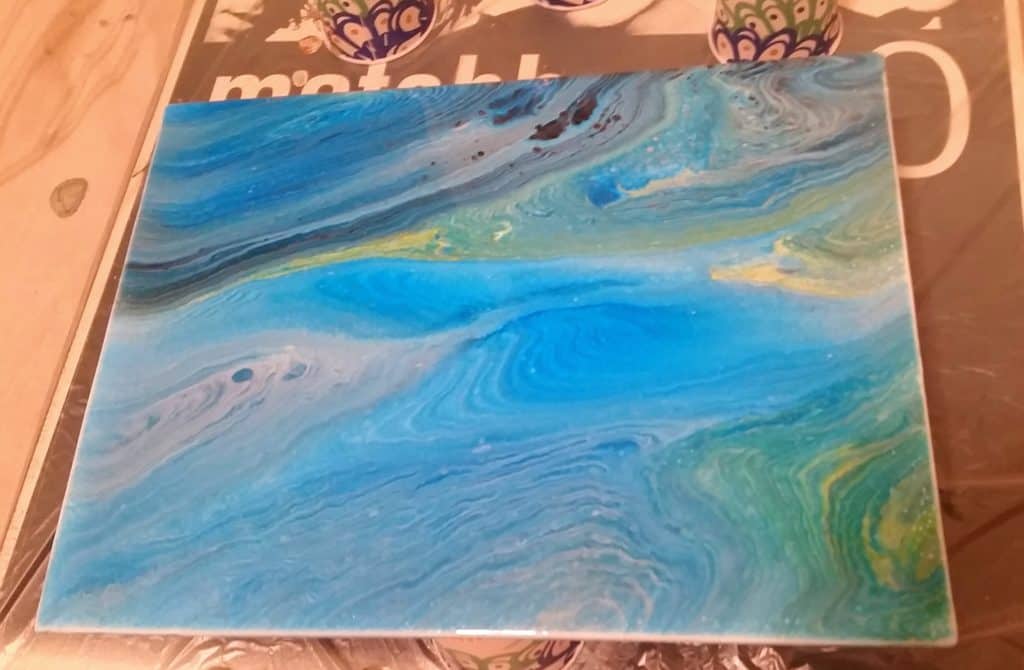
Well there are several reasons why this may be.
1: The colors are too close in shades or hues to each other—basically not enough contrast to begin with.
2: You may have used too much of one color vs. spreading out the colors in layers.
3: As was the case in this blue pour, I used a light gray as my base. When you use a color other than white as your base when pouring light colors, you will have a more subtle or even muddy result. Here the gray base gave the medium blue a lighter greyish blue tone, and almost over powered the yellow.
While this in no way encompasses all paint pouring issues I hope these have helped and given you some ideas of what to look for; and how to avoid some of the most common mistakes with paint pouring. I believe that everyone makes mistakes and needs a hand from time to time, and as fellow artists we need to be the one who lends it. Take care and never stop asking questions.
Since she began creating art in 2007, Tina Swearingen’s focus has evolved from repurposed conceptual art into the creativity and flow of acrylic pouring. Her pours are inspired by the movement and colors of Southern Arizona’s amazing thunderstorms, and the majestic beauty of the Pacific Northwest, which she now calls home.


May I use Children’s regular washable paint to do in school with my 9 year old students?
Saves lots of money!
I DO use liquid Tempera paints for elementary children’s classes. That and Elmer’s School Glue and distilled water as the pouring medium. Works great & is safe & affordable!
Thank you so much.
I’ve been getting pitted holes in my acrylic pours and I’m not sure why? No matter if I pour more paint over them, the paint still pulls away from those spots!
Thank you so much gor these tips I now realize on 2 Tips what I did wrong: too thick of base coat and mixing silicone way too much once it’s added to my colors! Redo time Thank you again Sharla 😊
Love all the tips and cures!
Hi Linda
I’ve just started acrylic pouring and some of my paints have dried with tiny little pin prick holes in them. Would you know why this might be?
Maybe too much paint on canvas?
Painting still looks nice but be nice without the holes.
Really, you can use coconut oil?? I never knew. Thank you!
No no no
Ogx hair serum with dimethicone. It is the dimethicone that helps with the cells. Coconut milk or oil doesn’t
Nik, this is the hair serum, Coconut Oil, not the cooking coconut oil. Just wanted to be sure we were talking the same thing. You can find it at most drugstores.
Walgreens has it for $6.69 OGX Nurishing Coconut Milk Anti-breakage serum, 4 fl oz.
Yes ogx coconut oil is the best just put tiny little drops. It comes out quick and then if there’s too much it comes out without cells and really slimy , even had paint start to pull away from the canvas I think best way to describe it.
I DO use liquid Tempera paints for elementary children’s classes. That and Elmer’s School Glue and distilled water as the pouring medium. Works great & is safe & affordable!
Thanks for answering so many of my ?
I made up Elmers and water to the consistency that everyone seemed to talk about. I did a dirty pour with silicone on a black base. Not one cell appeared even after torching. I have never had a problem with Floetrol and cells.
Love your tips and will be reading them all.
Very helpful. Thank you!
Thank you very much for this invaluable article. I am collecting supplies for my second pour as the first had all of the problems mentioned above. you have given me the confidence to try again and to avoid these pitfalls before I start.
You didn’t cover how to fix cracks. I had cracks show up in my painting. It was only in the white paint. What could I have done wrong?
Hey Charity, was it apple barrel white paint? A lot of people have reported issues with cracks for apple barrel white, so the way to fix it is to just use a different brand of white paint.
Could have been to thick, did you use floetrol or Elmer’s glue. Elmer’s blue can give you cracks in the paint! Sometimes cracks can be ok but not to much. I sometimes use crack paint to give it an crackle effect.
great info, i have stopped using plain white and now use pearl white for myself i love the results
Sometimes my paint looks in the middle as it dries even though it appears to be pretty even and level.
Hello, I’ll give this a try too. What brand dear?
So sorry folks, there has been a problem with receiving notices about comments. I am trying to answer all now – again, so sorry for the delay in answers!!
I have been having the same problem as Bianca
I’ve been getting pitted holes in my acrylic pours and I’m not sure why? No matter if I pour more paint over them, the paint still pulls away from those spots!
It is probably oil on hands or silicone causing that but be aware to much plain water with acrylic paint that not mixed well can cause these resistance spots also. I get them sometimes when just painting the canvas and I have dipped brush in water and tried to touch up one spot. Also lil pin homes are probably bibles not being piped before u start tilting
I too have the pitted holes. Little tiny pin pricks. I really look forward to hearing about why. This is the first time I have heard anyone even mention the pin pricks.
This paint pouring has been my salvation while I deal with everything else. Thank you for your post.
All of a sudden I am getting pitted holes. I have tried everything I can think of and it is still hapoening. Please help .
Hi i did an acrylic pour for first time yesterday and my paint has sunk into canvan did i use too much water? Mixing my paint and maybe not enough floetrol?
I am also having trouble with pitted holes I noticed it in my white base layer. It’s like the paint won’t cover certain spots. I didn’t think I change the ratio of paint to flood but what else could it be. Could it be to much Floetrol?
Hi I’m really frustrated. I can’t get my paint to form a stream into the cup. It drips and doesn’t flow , I’ve tried adding medium or water, still can’t get it to happen. I even bought acrylic pouring paint to check the consistency but I can’t replicate it, help!
I just bought Artsmith paint from Joann’s and it was horrible paint! It took forever to stir in the medium and then it started clumping! I thought it was only one color but it was all of them! I immediately took them back and returned them.
Brand can make All the difference!
Hi Fran. I’m having the same issue here. Does the canvas end up having bumps or ridges on it? It seems the drips end up leaving the canvas with ridges / bumps if this happens. I try to pick these off the canvas while it still is very wet. By the way, I have shaken, stired, etc. these certain paints and I believe I’ll have to buy these colors again huh?
Having trouble after dry… paintings turn very dark even with very vibrant colors. Have done many paintings in the past with this issue.
When I am doing the pour on canvas I end up smudging the sides of the pour and it looks awful. How can I avoid or fix this?
I did 2 pours last night and for the first time, after lightly torching, very miniscule white paint dots (pin prick size) can be seen splattered on the dark colors, barely visible if not scrutinizing. Doesn’t look bad… just surprised me. It’s as though the torching caused the white paint to splatter elsewhere for some reason. Any ideas? I will add that the white pillow paint was not too thin.